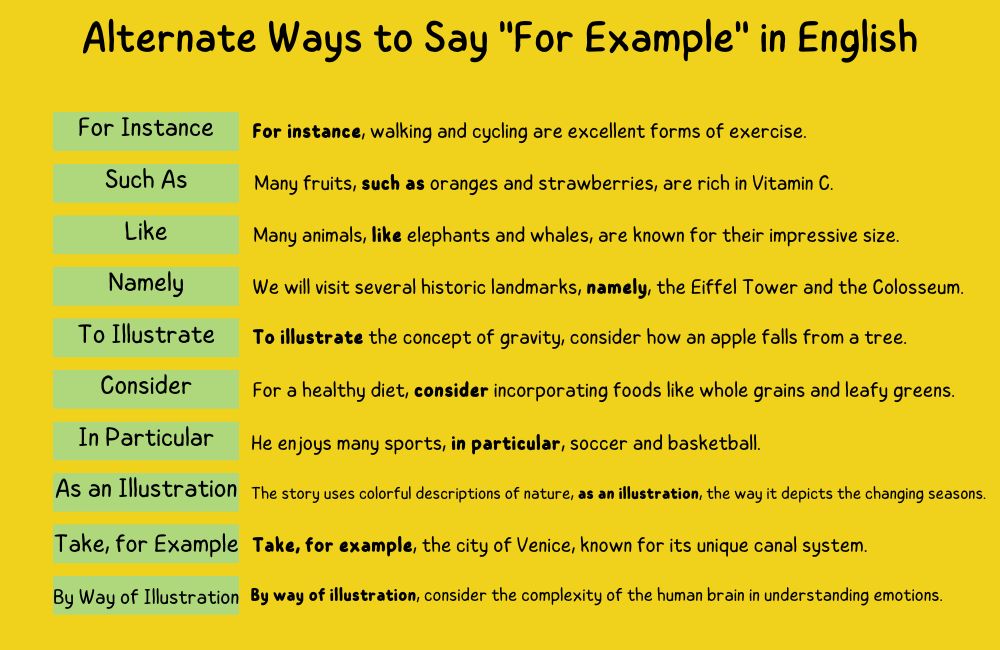This article covers the following areas –
As a rich and evolving language, English offers many ways to express a single idea. As someone who frequently engages in writing and speaking, finding diverse expressions to convey the same meaning is not just a skill but an art. Today, I’m delving into one such aspect: alternatives to the commonly used phrase “for example.” This exploration is about listing synonyms and providing context, usage, and insight into how these alternatives can enrich your communication.
Alternate phrases for “For Example” in English include “For Instance,” indicating a specific case; “Such As,” listing category elements; “Like,” for casual emphasis; “Namely,” to specify details; and “To Illustrate,” vividly clarifying a point. Explore more nuanced alternatives.
Continue reading to discover additional versatile expressions like “Consider,” “In Particular,” and others, each offering unique contextual applications to enhance your communication skills in both formal and informal settings.
Why Do You Need Alternatives to “For Example”
“For example” is a classic phrase to introduce an instance or illustrate a broader point. However, constant repetition can render your writing or speech monotonous and predictable. Expanding your vocabulary with alternatives not only breaks this monotony but also enhances the precision and tone of your message.
Different contexts call for different expressions. For instance, in a formal report, “for instance” might be preferable, while in a casual conversation, “like” or “such as” could be more fitting. Understanding the subtle nuances of each alternative ensures your language is always context-appropriate.
The tone of your communication can significantly influence its impact. Alternatives to “for example” allow you to adjust the tone – from formal and academic to casual and conversational – thus making your language more dynamic and engaging.
10 Alternate Ways to Say “For Example”
In the realm of English communication, variety is not just the spice of life but the essence of effective expression. The phrase “for example” is a staple in our language diet, yet many flavorful alternatives can enhance our verbal and written meals.
Each alternative carries its own unique texture and taste, suitable for different contexts and audiences. Let’s explore these alternatives, understanding their specific uses and the subtle shades of meaning they bring to our conversations and writings.
1. For Instance
A close cousin to “for example,” “for instance” is versatile, fitting comfortably in both formal and informal settings. It introduces an example with a slight emphasis, making it ideal for highlighting a specific case.
- Many cities are known for their unique cuisines. For instance, Naples is famous for its pizza.
- For instance, walking and cycling are excellent forms of exercise.
2. Such As
“Such as” is perfect for introducing examples from a larger group. It’s particularly useful in academic or professional writing when listing category elements.
- There are several ways to reduce energy consumption, such as using LED bulbs and turning off appliances when not in use.
- Many fruits, such as oranges and strawberries, are rich in Vitamin C.
3. Like
“Like” is informal and conversational, ideal for casual discussions. It introduces examples in a relatable manner, making your speech sound more natural and approachable.
- In summer, people enjoy activities like swimming and picnicking.
- Many animals, like elephants and whales, are known for their impressive size.
4. Namely
When you need to specify or clarify, “namely” is your go-to alternative. It’s more formal and is often used in academic and technical writing to introduce precise examples or details.
- The committee focuses on environmental issues, namely, deforestation and pollution.
- We will visit several historic landmarks, namely, the Eiffel Tower and the Colosseum.
5. To Illustrate
When you aim to explain or clarify a point vividly, “to illustrate” works wonders. It sets the stage for an example that serves as evidence and paints a clear picture for the reader or listener.
- To illustrate the concept of gravity, consider how an apple falls from a tree.
- The importance of hydration can be shown by to illustrate, noting how water affects plant growth.
6. Consider
Inviting the audience to engage with an example, “consider,” is both formal and interactive. It’s particularly effective in presentations or lectures where audience engagement is key.
- Consider, for example, the impact of social media on modern communication.
- For a healthy diet, consider incorporating foods like whole grains and leafy greens.
7. In Particular
“In particular” is used to draw attention to an especially relevant or significant example. It’s useful in both written and spoken English to focus the audience’s attention on a key point.
- He enjoys many sports, in particular, soccer and basketball.
- This region is known for its wildlife, in particular, the rare bird species that can be found here.
8. As an Illustration
“As an illustration” is a formal alternative, often used in academic or professional contexts. It introduces an example that serves as a clear representation of the broader concept or idea being discussed.
- As an illustration of rapid technological advancement, look at the evolution of smartphones over the past decade.
- The story uses colorful descriptions of nature, as an illustration, the way it depicts the changing seasons.
9. Take, for Example
“Take, for example,” is a more conversational and engaging way to introduce an example. It’s as if you’re inviting the listener or reader to consider a specific case or scenario directly.
- Take, for example, the city of Venice, known for its unique canal system.
- Consider the role of bees in pollination; take, for example, their impact on the growth of fruit trees.
10. By Way of Illustration
“By way of illustration” is a formal and somewhat elaborate way to introduce an example. It’s particularly useful in detailed explanations or when introducing a complex example that requires careful attention.
- By way of illustration, consider the complexity of the human brain in understanding emotions.
- The effects of global warming can be seen by way of illustration, in the melting of polar ice caps.
Each of these phrases uniquely enriches your language and makes your communication more effective and engaging. By choosing the right phrase for the right context, you can enhance the clarity and impact of your message.
Final Note
Diversifying your language with alternatives to “For Example” not only enriches your vocabulary but also sharpens your communication skills. Each alternative, from the formal “Namely” to the conversational “Like,” offers a unique way to convey examples, allowing for precise, engaging, and context-appropriate communication.
Whether writing academically, speaking professionally, or engaging in casual conversation, these alternatives add depth and clarity, making your expression more effective and impactful. Embracing this linguistic variety ensures your language remains vibrant and resonant in any setting.





